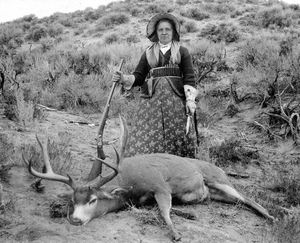Big game trophies: What’s in YOUR closet?
HUNTING -- Only a small proportion of hunters gets the chance to harvest a record-book animal. But all of us get the urge to know where our personal-best deer, elk and other critters rank in the big picture. And sometimes people are surprised.
Big-game trophy measuring by certified scorers is open to anyone. Hunters can take advantage of session Saturday and Sunday at Cabela's in Post Falls.
The Boone and Crockett Club, the Pope and Young Club, and the Longhunter Society maintain separate lists of ‘record’ sized specimens of big game animals from across North America. The Idaho Department of Fish and Game maintains a record list of big game animals from Idaho.
Pope and Young recognizes big game taken with archery equipment.
Longhunter Society entries are limited to big game taken by muzzleloader hunters.
Boone and Crockett and Idaho Department of Fish and Game accept entries of exceptional animals taken by any hunting method, emphasizing the noteworthy wildlife specimen rather than the means by which it was obtained. Both also accept specimens that are found dead and subsequently picked up when legal to do so. These mortalities can be from a wide range of causes such as road kills, winter kills, predation, falls, disease, trains, locked antlers…any of the many ways a big game animal may die.
Phil Cooper, Idaho Fish and Game Department wildlife educator and certified scorer, offers this insight:
Some Boone and Crockett entries have been recognized only after hanging in barns or homes for decades. For example, the ‘hole in the horn’ buck is the second largest non-typical whitetail deer ever recorded. It was found dead by railroad workers along train tracks in Portage County, Ohio in 1940. It was on the wall in a local business for 43 years before anyone decided to have it measured in 1983.
Big game record keeping organizations hold training classes to certify volunteer individuals to measure specimens. These measurers use criteria developed by the organizations to calculate an official score. Measurers are not paid and cannot charge for measuring.
Each organization has a minimum score for the species of big game animals they accept. Minimum scores for entry differ to take into account the greater challenge of taking an animal using primitive hunting equipment. Archery record books (published by Pope and Young) and muzzleloader record books (published by the Longhunter Society) have lower minimum scores for entry than rifle or picked up entries found in the Boone and Crockett record book and IDFG big game records list. The clubs publish record books every few years listing the entries meeting or exceeding their minimum requirement.
Specimens must air dry for 60 days at room temperature before they can be officially measured. There is some shrinkage that occurs as antlers, horns, and skulls dry out, so the 60 day requirement ensures all are measured on equal terms.
The IDFG list of big game animals taken in Idaho is available online. The annual deadline for submissions is April 1 to be included in the update that is done May.
Minimum scores for the Idaho Records List are posted online, by species. The minimums follow the Boone and Crockett model, as the minimums do not differ for rifle, muzzleloader, archery and picked-up antlers or horns. To enter a trophy into the Idaho Records List, it must first be measured by an official measurer. Lists of measurers are found online, or they can be obtained by contacting any IDFG office.
In addition to the official measuring at Cabela's on Saturday and Sunday, Feb. 13-14, the public can bring trophies for scoring at the Bonner County Horn Show in Sandpoint the first weekend of March, and the Big Horn Outdoor Recreation Show, March 17-20 at Spokane County Fair and Expo Center.

